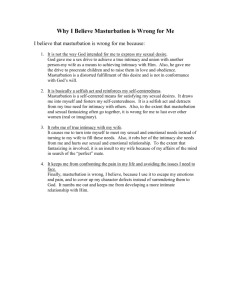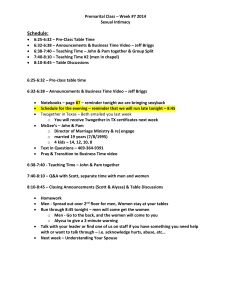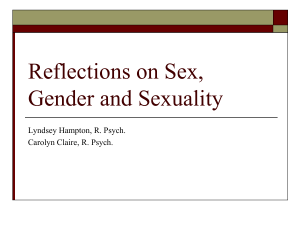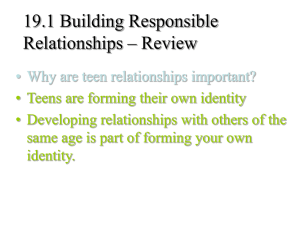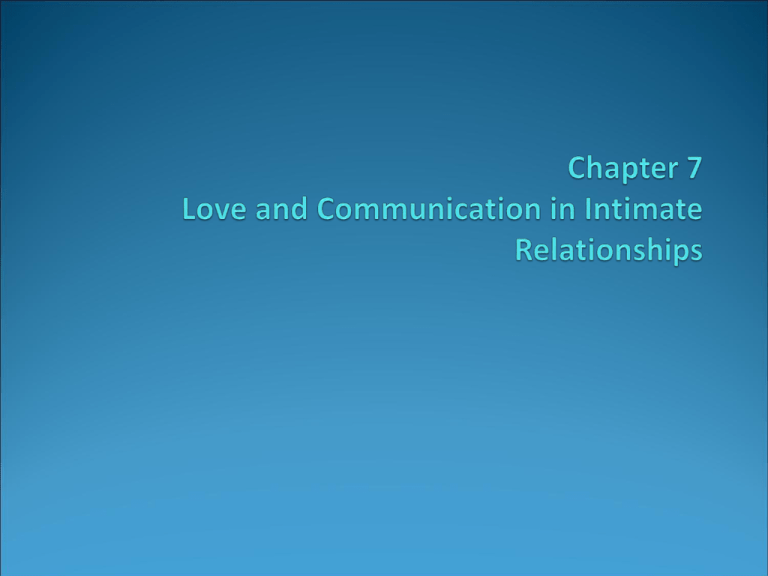
What is Love?
Difficult to define
Special attitude with behavioral and emotional
components
Different things to different people
Difficult to measure
Rubin’s Love Scale
13-item questionnaire
3 components of love
Attachment
Caring
Intimacy
Sternberg’s Triangular Theory
Passion, Intimacy, & Commitment are the three
components of love
Passion builds then fades
Intimacy & Commitment continue to build
Variations in components yield different kinds of love
Intimacy alone = friendship
Passion alone = infatuation
Commitment alone = empty love
Sternberg’s Triangular Theory
Falling in Love
The chemistry of love
Neurotransmitters
Mentioned last class
Endorphins
Chemicals - euphoria, peace, tranquility
Loss of romantic love and neurotransmitter withdrawal
Falling in Love: Proximity
Proximity
Mere exposure effect
Familiarity breeds predictability which leads to greater
comfort
Greater proximity often reflects shared interests
Falling in Love: Similarity
Similarity
Level of physical attractiveness
Age, educational status, and religion
Race and ethnicity
Why Similarity?
Share similar interests & activities
Communicate better
Confirm own views & experiences
Supportive of values & beliefs
Falling in Love: Reciprocity
Reciprocity
When someone shows they like us, we tend to like them
back
Increases in self-esteem
Increases likelihood of relationship enduring
Falling in Love: Physical Attractiveness
Belief that “What’s beautiful is good”
Status by association
Most important in early stages
May be an indicator of physical health
Heterosexual males place greater emphasis on physical
attractiveness
Attachment
Intense emotional tie
Adult attachments are influenced by our attachment
to caregiver in infancy
Attachment
Attachment styles in Adulthood
Paired couples often are similar in their attachment
styles
Attachment style affects interaction in relationship
Attachment Styles and Relationships
Issues in Loving Relationships
Relationship between love & sex
Relationship between the two is not always clear
Consider “hook-ups” and “friends with
benefits”
Questions to ask:
Does sexual intimacy deepen a love
relationship?
Do men and women have different views of sex
& love? How does age impact this?
Sexual Orientation and Attitudes
about Love & Sex
Many people stereotype same-sex relationships as
primarily sexual
Sex differences among lesbians and gay men are
consistent with general sex difference in attitudes
toward love and sex
Gay men are more likely than lesbians to
separate love from sex
Lesbians more likely to postpone sex until
intimacy has been established
Jealousy in Relationships
Jealousy-prone person
Low self-esteem
High value on wealth and popularity
Negative consequences
Precipitates partner violence
Stifles relationship development
Raises anxiety, depression, anger
Sex differences
Women (her fault)
Men (partner or third person’s fault)
Maintaining Relationship Satisfaction
Ingredients in a lasting love relationship
Self-acceptance
Appreciation of each other’s qualities
Commitment
Good communication, realistic expectations and shared
interests
I versus You communication
Ability to face and deal with conflict
Know how to compromise
Maintaining Relationship Satisfaction
Characteristics of high quality relationships
Supportive communication
Companionship
Sexual expression and variety
Although not always variety…
Seeing partner as best friend
Maintaining frequent positive interaction
Maintaining Relationship Satisfaction
Individual and relationship growth
Growth and change maintain relationship
Overcome obstacles
View problems as challenges
Negotiate and renegotiate wants
Accept each other as unique
Maintaining Relationship Satisfaction
Sexual Variety
Communication is critical
Listen to needs
Must communicate yours! No mind readers!
Be spontaneous
Sometimes need to plan for intimate time
Don’t worry about frequency “standards”
Celibacy
Types of Celibacy
Complete celibacy
Neither masturbates nor has sexual contact
with another person
Partial celibacy
Reasons for or Benefits of Celibacy
Religious, moral beliefs
Waiting for the appropriate person
Learning about other aspects of self
Health considerations
During substance abuse recovery
Erotic Dreams
Expression and exploration of desires
Most males, two thirds females
Nocturnal orgasm
Both sexes
Women have higher frequency of intercourse and of
orgasm with masturbation more likely aware
Erotic Fantasy
Daydreams, masturbation, or during sexual
encounters
95% of women and men fantasize
Fantasy content among heterosexual and nonheterosexual individuals are similar, except for sex
of imagined partner
Sexual Fantasy
Function of sexual fantasies
Source of pleasure & arousal
Overcome sexual anxiety
Acceptable expression of socially unacceptable behavior
Gender similarities & differences
Women more likely to use romance
Men more likely to have domination fantasies
Women more likely to have submission fantasies
Fantasies: Help or Hindrance?
Most research points to helpful
Healthy part of sexuality
May actually enhance a relationship
How might fantasies be harmful?
Perspectives on Masturbation
Traditional Condemnation
Censured as non-procreational
Erroneous health concerns
Tissot, Graham, Kellogg
Contemporary research has established that it is
not harmful
Differences by race, gender, education
White male, married, college grad
Purposes for Masturbation
Relieves sexual tension
Means of self-exploration
Shared experience
Common among married couples
More frequent sex = more frequent masturbation
Not dissatisfaction
Assists in physical relaxation
Self-Pleasuring Technique
Follow your moral values
Set aside adequate time & relax
Experiment with different types of touch
Kissing and Touching
Kissing
Cross-cultural practices and attitudes toward kissing
Touching
Cornerstone of human sexuality
Whole body is responsive
Specific erogenous zones
Touching: Manual Stimulation of Genitals
Individual differences with regard to manual
stimulation
Most women need consistent touching through
orgasm
Usually hand movements against mons and clitoris
Men may not like to be touched just after orgasm
Gay Male Sexual Behaviors
Misconceptions
One “wears the dress”
Realities
Similar to noncoital heterosexual behaviors
Fellatio, mutual masturbation are most common
Compared to other men, gay men often have more
diversity, self-expression, & personal enjoyment in their
sexual contact
Lesbian Sexual Expression
Misconceptions
Idea of wearing dildo
Artificial penis
Realities
Similar to noncoital heterosexual behaviors
Lesbian sexual relations tend to be longer and involve
more all-over body sensuality
Oral-Genital Stimulation
Types: cunnilungus & fellatio
Acceptance varies
69 refers to simultaneous oral-genital
stimulation
Anal Stimulation
Prevalence is lower than other forms of sexual
activity
Health risk (HIV, other infections)
Lubricants and gentle insertion needed
Bad idea to have vaginal sex after anal

